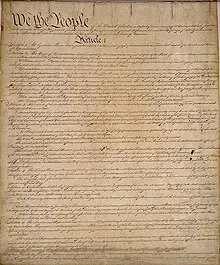Title of Post
Comntent of Post
Paragragh
......
.
.
.
The oldest classical Greek and Latin writing had little or no space between words and could be written in boustrophedon (Abre numa nova janela) (alternating directions). Over time, text direction (left to right) became standardized, and word dividers (Abre numa nova janela) and terminal punctuation (Abre numa nova janela) became common. The first way to divide sentences into groups was the original paragraphs (Abre numa nova janela), similar to an underscore (Abre numa nova janela) at the beginning of the new group.[2] (Abre numa nova janela) The Greek parágraphos evolved into the pilcrow (Abre numa nova janela) (¶), which in English manuscripts in the Middle Ages (Abre numa nova janela) can be seen inserted inline between sentences. The hedera leaf (Abre numa nova janela) (e.g. ☙) has also been used in the same way.

Indented paragraphs demonstrated in the US Constitution
In ancient manuscripts, another means to divide sentences into paragraphs was a line break (newline (Abre numa nova janela)) followed by an initial (Abre numa nova janela) at the beginning of the next paragraph. An initial is an oversized capital letter, sometimes outdented beyond the margin of the text. This style can be seen, for example, in the original Old English (Abre numa nova janela) manuscript of Beowulf (Abre numa nova janela). Outdenting is still used in English typography, though not commonly.[3] (Abre numa nova janela) Modern English typography usually indicates a new paragraph by indenting (Abre numa nova janela) the first line. This style can be seen in the (handwritten) United States Constitution (Abre numa nova janela) from 1787. For additional ornamentation, a hedera leaf or other symbol can be added to the inter-paragraph white space, or put in the indentation space.
A second common modern English style is to use no indenting, but add vertical white space to create "block paragraphs." On a typewriter, a double carriage return (Abre numa nova janela) produces a blank line for this purpose; professional typesetters (or word processing (Abre numa nova janela) software) may put in an arbitrary vertical space by adjusting leading (Abre numa nova janela). This style is very common in electronic formats, such as on the World Wide Web (Abre numa nova janela)and email (Abre numa nova janela). Wikipedia itself employs this format.[citation needed (Abre numa nova janela)]